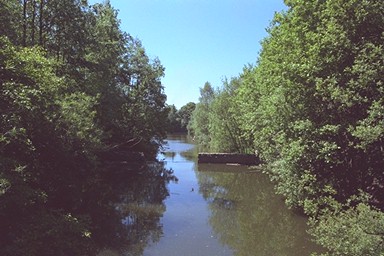Exploring Telford
The Old Canal System


As a small boy, I remember being fascinated by the Macclesfield canal near my home, and the Lancaster canal near my grandmother's. As a teenager, I walked along lengths of the Macclesfield canal, wondering what it would be like to be in a boat and envying those people (relatively few in those days) who were.
On coming to Telford, I learned that there had once been an extensive canal network, almost all of which had vanished. I was interested, but for ten years did nothing about it. I knew that the Silkin Way between Town Park and Madeley is the line of an old railway, and I had read in the Ironbridge Gorge Museum that the railway was built on the bed of the canal.
Then, in August 1996, my parents came on a visit, went for a walk and got lost. On their eventual return, they asked a great many questions about the railway and canal network, most of which I couldn't answer. In particular, my father asked where the Aqueduct had been. I told them what I had been told locally, and never questioned - "It's still there - the big bridge opposite the Britannia". To which they retorted that it couldn't be - the path above was sloping. Now of course, you can't build a canal on a slope - all the water would fall out at the bottom. So at that point at least, the railway was not built on the canal bed.
So I started exploring. I got more and more fascinated, and decided to find out what remained of the whole system. At the same time, I wanted to do something about my increasing corpulence, so this was to be an exercise in exploration, not in research in libraries. Naturally, I ran the risk of making mistakes which proper research would avoid. This is not an academic research paper, and much of what I have learned, deduced or guessed must be recorded in the county's libraries and archives, and be already well known to local historians. That's not the point - I wanted to find out for myself by exploration. Nevertheless, as time went on I accumulated a certain amount of paperwork - see Sources.
It has been (and still is) enormous fun, and the comments I have received via my guestbook from people who have enjoyed viewing Explofing Telford have been an ample reward for the effort of recording it.
I have not researched this exploration as a historian should, nor cited my sources properly. However, for those interested, I have used for my assistance:
This is a survey of where the canals ran, and a description of where sections or traces can still be seen - and no more. Those interested in the history of their construction, use and decline will not find answers here, but they are not hard to come by in the local libraries and museums.
Although I make no pretensions that this is an academic paper, and have not included all my evidence (in particular, citations of written sources), I wish to avoid wilfully misleading anyone.
Three kinds of statement will be found in this account:
I have made many mistakes. The ones I know I have made have been corrected (although some have been perpetuated in Stories of the Hunt). If anyone can point out to me any further bludners, or traces I have missed, I would be delighted to be told. Please mail me!
All street names and other references will be found on the Telford Street Map published by Wrekin District Council, unless otherwise stated. Of course, nearly all will be newer than the canal, so for example, "it crossed Queen Street" should be read as "it crossed where Queen Street is now".